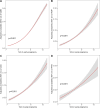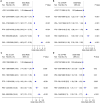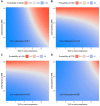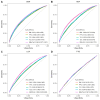Pre-pregnancy BMI modifies the associations between triglyceride-glucose index in early pregnancy and adverse perinatal outcomes: a 5-year cohort study of 67,936 women in China
- PMID: 39762964
- PMCID: PMC11702117
- DOI: 10.1186/s13098-024-01550-2
Pre-pregnancy BMI modifies the associations between triglyceride-glucose index in early pregnancy and adverse perinatal outcomes: a 5-year cohort study of 67,936 women in China
Abstract
Background: Triglyceride-glucose (TyG) index was suggested as a possible surrogate for insulin resistance and a predictor for cardiovascular diseases and diabetes in the non-pregnant population. However, the relationship between TyG index in early pregnancy and adverse pregnancy outcomes (APOs), and the contribution of pre-pregnancy body mass index (BMI) was still illusive.
Methods: A large retrospective cohort study involving 67,936 pregnant Chinese women between 2017 and 2022 was conducted. Data collection and laboratory tests were performed during the usual patient care. TyG index was calculated using ln [fasting plasma triglyceride (TG; mmol/L) × 88.5 × glucose (FPG; mmol/L) × 18.02/2]. Multivariable logistic regression models were applied to explore the relationship between TyG index and APOs. Interaction and stratification analyses were performed to assess the influence of pre-pregnancy BMI on the association. In addition, ROC curves were used to evaluate the potential predictive value of the TyG index and pre-pregnancy BMI.
Results: Positive associations between maternal early pregnancy TyG index and APOs, including gestational diabetes mellitus (GDM), hypertensive disorders of pregnancy (HDP), large for gestational age (LGA) and preterm birth (PTB) were demonstrated (all P < 0.001). Besides, there was a significant interaction effect of maternal pre-pregnancy BMI and TyG on the risk of GDM, HDP and LGA (P < 0.05). Women of pre-pregnancy overweight/obesity (OWO) with TyG index in the fourth quartile were at an increased risk for GDM [adjusted OR (aOR) and 95% CI, 3.82 (3.14-4.64)], HDP [aOR 95% CI, 1.34 (1.10-1.64)], for LGA [aOR 95% CI, 1.78 (1.44-2.19)], and PTB [aOR 95% CI, 1.53 (1.11-2.09)], compared with OWO mothers with TyG in the lowest quartile. In addition, the combination of BMI and TyG enhanced predictive performance for APOs, particularly in women with normal plasma TG and FPG levels.
Conclusions: Dose-response relationships were identified between elevated maternal TyG index in early pregnancy and APOs. A combination of early pregnancy TyG index and pre-pregnancy BMI may provide predictive value for APOs, even in low-risk women. Thus, early screening of fasting blood lipids and glucose simultaneously may be useful and convenient for the early identification of APOs, both among OWO and low-risk normal-weight women.
Keywords: Gestational diabetes mellitus; Hypertensive disorders of pregnancy; Large for gestational age; Pre-pregnancy BMI; Preterm birth; Triglyceride-glucose index.
© 2024. The Author(s).
Conflict of interest statement
Declarations. Ethics approval and consent to participate: The study protocol was endorsed by the IPMCH Medical Ethics Committee (GKLW2023-006, the date of approval was 7 Febrary 2023). Analysis of data in this study were conducted from 2023 to 2024. The requirement for informed consent was waived for using anonymized and de-identified data as approved by the IPMCH Ethics Committee. Consent for publication: Not applicable. Competing interests: The authors declare no competing interests.
Figures




Similar articles
-
The first-trimester triglyceride glucose-body mass index is a valuable predictor for adverse pregnancy outcomes.BMC Pregnancy Childbirth. 2025 Feb 11;25(1):142. doi: 10.1186/s12884-025-07258-z. BMC Pregnancy Childbirth. 2025. PMID: 39934742 Free PMC article.
-
Association of the Triglyceride-Glucose Index During the First Trimester of Pregnancy with Adverse Perinatal Outcomes.Diagnostics (Basel). 2025 Apr 29;15(9):1129. doi: 10.3390/diagnostics15091129. Diagnostics (Basel). 2025. PMID: 40361947 Free PMC article.
-
An elevated triglyceride-glucose index in the first-trimester predicts adverse pregnancy outcomes: a retrospective cohort study.Arch Gynecol Obstet. 2025 Mar;311(3):915-927. doi: 10.1007/s00404-025-07973-0. Epub 2025 Feb 26. Arch Gynecol Obstet. 2025. PMID: 40009162 Free PMC article.
-
Association between prepregnancy body mass index or gestational weight gain and adverse pregnancy outcomes among Chinese women with gestational diabetes mellitus: a systematic review and meta-analysis.BMJ Open. 2024 Feb 17;14(2):e075226. doi: 10.1136/bmjopen-2023-075226. BMJ Open. 2024. PMID: 38367974 Free PMC article.
-
Dietary supplementation with myo-inositol in women during pregnancy for treating gestational diabetes.Cochrane Database Syst Rev. 2016 Sep 7;9(9):CD012048. doi: 10.1002/14651858.CD012048.pub2. Cochrane Database Syst Rev. 2016. PMID: 27602537 Free PMC article. Review.
References
-
- Fraser A, Nelson SM, Macdonald-Wallis C, Cherry L, Butler E, Sattar N, et al. Associations of pregnancy complications with calculated cardiovascular disease risk and cardiovascular risk factors in middle age: the Avon Longitudinal Study of Parents and Children. Circulation. 2012;125(11):1367–80. - PMC - PubMed
-
- Diagnostic criteria and classification of hyperglycaemia first detected in pregnancy: a World Health Organization Guideline. Diabetes Res Clin Pract. 2014;103(3):341–63. - PubMed
Grants and funding
LinkOut - more resources
Full Text Sources
Miscellaneous

